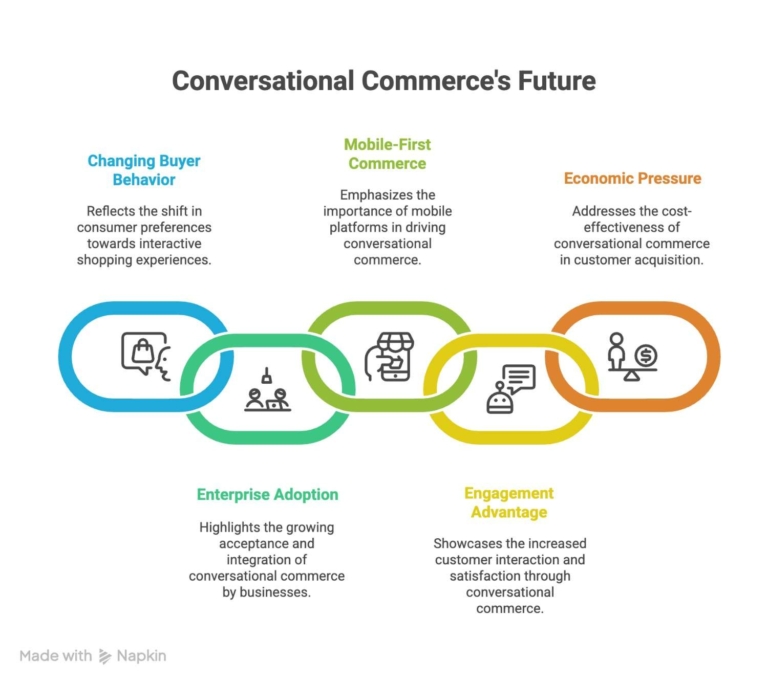Greetings! I'm Aneesh Sreedharan, CEO of 2Hats Logic Solutions. At 2Hats Logic Solutions, we are dedicated to providing technical expertise and resolving your concerns in the world of technology. Our blog page serves as a resource where we share insights and experiences, offering valuable perspectives on your queries.

Key Takeaway: Conversational commerce isn’t just a trend, it’s becoming the primary way customers want to shop. Global consumers will spend $290 billion via conversational commerce channels in 2025. Businesses that implement chat and voice shopping now will capture more customers, reduce acquisition costs, and create better shopping experiences than competitors still relying on traditional eCommerce alone.
What Is Conversational Commerce and How Does It Work?
Conversational commerce uses messaging apps, chatbots, and voice assistants to create shopping experiences through natural conversation. In traditional e-commerce customers had to browse websites. Conversational commerce lets people discover, compare, and buy products through chat or voice commands.
Key differences from traditional eCommerce:
- Real-time, two-way conversations instead of one-way browsing
- Personalized recommendations through AI-powered chat
- 98% open rates vs 1% for unsolicited emails
- 45-60% conversion rates vs 2-3% for email campaigns
Voice shopping vs chat-based commerce: Voice shopping uses assistants like Alexa and Google Assistant for hands-free purchases. Chat-based commerce happens through messaging apps like WhatsApp, Facebook Messenger, and live chat widgets.
Why Conversational Commerce Is the Future of Online Shopping

Changing buyer behavior: Modern consumers expect instant, personalized help. Most of them consider experience an important part of their buying decision. Conversational commerce delivers this through immediate responses and tailored recommendations.
Enterprise adoption: 89% of companies are using or testing AI, with major retailers like Walmart implementing AI assistants and Wendy’s rolling out AI ordering to 500-600 drive-thrus by end of 2025.
Mobile-first commerce dominance: 3.1 billion people use WhatsApp globally, and messaging apps have become the primary communication method for younger generations. The best method is to reach the customers in their favorite apps to shop.
Massive engagement advantage: Traditional marketing channels are losing effectiveness fast. Whatsapp messages has more reach than the email open rates. The attention is shifting to conversational channels, and smart brands are following.
Economic pressure on customer acquisition: As digital advertising costs continue rising, conversational commerce offers a more cost-effective way to acquire and retain customers. Conversational commerce reduces customer service and improving conversion rates.
How Voice Shopping Is Changing the Way People Buy
49% of U.S. consumers use voice search for shopping (128.4 million Americans), with voice shopping consumers projected to spend $81.8 billion worldwide in 2025.
Popular voice assistants and market share:
- Google Assistant: 92.4 million U.S. users
- Apple Siri: 87.0 million U.S. users
- Amazon Alexa: 77.6 million U.S. users
Common use cases:
- Product search and discovery
- Smart speaker users plan to make purchases using voice in the next month
- Reordering frequently bought items
What Platforms and Tools Power Conversational Commerce?
Messaging platforms:
- WhatsApp Business: 3.1 billion users with 98% open rates and 50-60% CTR
- Facebook Messenger: Integrated with Facebook’s advertising ecosystem
- Live chat: Direct website integration for real-time support
Voice assistants:
- Amazon Alexa (smart speakers and devices)
- Google Assistant (phones and smart home)
- Apple Siri (iOS ecosystem)
AI and integration tools:
- AI chatbots for automated responses
- CRM integrations for customer data
- E-commerce platform connections (Shopify, Shopware, WooCommerce)
What Are the Benefits of Conversational Commerce for Brands?
Engagement and conversion improvements
Live chat helps to increase the conversion rates. The average order value increases when customers use live chat before buying. Apart from that proactive chat conversations helps to reduce the cart abandonment rates
Cost efficiency
Conversational commerce reduces customer service costs with automated support 24/7. This means you can handle it without additional staffs.
Better personalization
AI-powered recommendations based on conversation history and customer preferences create more relevant product suggestions.
Customer data and insights collection:
Every conversation provides rich qualitative data about customer preferences, pain points, and buying triggers. Conversation analytics reveal which products need better descriptions or which features customers care about most
Competitive differentiation and brand loyalty:
While most competitors still rely on static websites and slow email support, conversational commerce makes you stand out as modern and customer-focused. Personal conversations build stronger emotional connections than traditional e-commerce interactions
How to Implement Conversational Commerce in Your Online Store
Start small strategy:
- Begin with live chat: Add a simple chat widget to your website
- Test WhatsApp Business
- Automate common queries: Use chatbots for FAQs and order tracking
Essential tools and setup:
- Choose a Business Solution Provider (BSP) for WhatsApp Business API
- Set up automated message templates
- Integrate with your CRM and eCommerce platform
- Train staff on conversational selling techniques
Key performance indicators:
- Message open rates and response times
- Conversation-to-sale conversion rates
- Customer satisfaction scores
- Average order value from conversational channels
What Challenges Does Conversational Commerce Face?
Technical challenges:
- Integration complexity with existing systems
- Managing high message volumes efficiently
- Ensuring consistent brand voice across channels
Privacy and compliance: Regulatory frameworks like GDPR and CCPA are increasing adoption of secure conversational solutions, requiring businesses to prioritize data privacy.
Human vs automation balance: While AI handles routine queries, complex issues still need human touch. Over 50% of customers expect businesses to be available 24/7, making this balance crucial.
What’s Next? Trends Shaping the Future of E-commerce
AI and NLP advancements: AI and machine learning are enabling unprecedented personalization, with chatbots becoming more sophisticated in understanding context and intent.
Multimodal interfaces: Integration of AR with shopping experiences allows customers to visualize products in their space before purchasing through chat interfaces.
Predictive conversations: AI will proactively reach out to customers with relevant offers based on browsing behavior and purchase history.
Geographic expansion: India leads with 17.8% CAGR growth, driven by smartphone penetration and mobile-first shopping experiences, while conversational commerce will represent over 20% of total online sales in Mexico by 2025.
Conclusion
Conversational commerce is becoming essential for e-commerce survival. Businesses using chat and voice shopping are capturing customers that others lose to slow, impersonal experiences.
Your customers are already messaging on WhatsApp, asking Alexa questions, and expecting instant responses. The choice is simple: meet them where they are, or watch them buy from competitors who do.
Contact 2Hats Logic Solutions today to discover how conversational commerce can boost your sales, reduce costs, and create the personalized shopping experiences your customers demand.
FAQ
What is conversational commerce in e-commerce?
Conversational commerce uses AI-powered chatbots, voice shopping, and messaging apps to let customers browse, ask questions, and buy products through real-time conversations.
How do AI-powered chatbots improve conversational commerce?
AI-powered chatbots offer personalized recommendations, quick answers, and secure checkout inside messaging platforms like WhatsApp or Facebook Messenger.
Why is voice shopping part of conversational commerce?
Voice shopping lets customers place orders, track deliveries, and get product details using smart assistants like Alexa or Google Assistant, enhancing convenience and speed.
Table of contents
- What Is Conversational Commerce and How Does It Work?
- Why Conversational Commerce Is the Future of Online Shopping
- How Voice Shopping Is Changing the Way People Buy
- What Platforms and Tools Power Conversational Commerce?
- What Are the Benefits of Conversational Commerce for Brands?
- How to Implement Conversational Commerce in Your Online Store
- What Challenges Does Conversational Commerce Face?
- Conclusion

Related Articles







